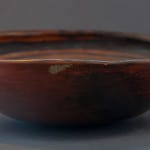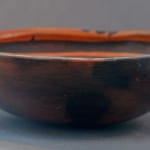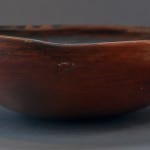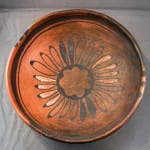Bowl 2013-16 is formed of grey clay covered by a thick yellow clay slip that fired dark red. The bowl has a rounded bottom and is symmetrical, although the edge is uneven. A slight extra coil of clay has been added to reinforce that edge and the bowl is in near “as fired” condition.
Four sets of three black spots set at the cardinal points mark the rim of the vessel. The pot was outdoor fired without protective shards and about half the bowl (both interior and exterior) are consequently black smudged by the flames.
Ed Wade and I discussed photographs of this pot at his home in Sedona, Arizona on October 13-14, 2003. Ed believes the pot dates from about 1900 to 1905.
Circular shapes with protruding feathers similar to that on bowl 2013-16 were frequently painted on the ancient kiva murals at Awatovi. Watson Smith calls these images “sun shields” and interprets the feathers as “rays of the sun” (1952:130). See figures 72a&c, 73, 84b and 89c in Smith for examples. Ed believes that such “power shield” designs are still drawn by men in the kivas at Hopi. These are ritual shields that provide an “osmotic portal” or “activated doorway” (Ed’s phrases) to a mystic realm. Such images are sacred and powerful and these images in the kiva (painted by men) are generally destroyed after use.
If Ed is correct, one surmises that a woman has drawn this image on bowl 2013-16 given what she has been told by an initiated male. Ed interprets the feathers as flicker (clear with black tip) and magpie (black). The white feathers with black tip are of an unknown species but indicate “north” and “winter” according to Wade. The center of the design represents an eight-lobe flower.
Such portals to a mystic realm are the concern of an extensive article by Karl Taube (2010). He writes that “feathered-rimmed passages are common in Pueblo IV kiva art, including Pottery Mound and Awat’ovi” and cites numerous sources, including Watson Smith (2010:104). This tradition is shared with ancient Mexican cultures: “In Olmec, Teotihuacan and Puebloan imagery, supernatural passageways can be rimmed with feathers, a motif probably alluding to a circular flower” (2010:120). Siitalpuva: “land brightened with flowers” is a central Hopi ideal and goal (Hays-Gilpin 2006 and 2010a & b) to which a portal would give access. The central eight-lobed flower form at the center of the design on bowl 2013-16 may indicate such a world.
Taube reproduces the image of an ancient Sikyatki jar (Peabody Museum catalog #2096) with its mouth surrounded by feathers, an image very close to the iconography on bowl 2013-16 (2010:109b). In its role as an osmotic portal to the mystic world, the iconography on bowl 2013-16 has much the same function a medicine bowls 2005-17 and 2005-18 in this collection. The University of Colorado Museum of Natural History has a Kawaikuh bowl (ca. 1400-1625 CE) that was part of a 2013/2014 Nampeyo exhibit at the Denver Museum of Art. The UC bowl (catalog #67.2010) is polychromatic and has four butterfly, feather, arrow-like images arranged around a central portal that shows a bit of design at its center. (Photograph on file.) While the specific form of the iconography is different than other feather-rimmed passages discussed above, the religious intention seems the same.
Speaking of pre-historic Sikyatki pottery, Kelly Hays-Gilpin et. al comment, “Some pottery paintings may also refer to ritual responsibilities of particular ritual societies and others may have displayed images that were valued and understood by everyone who saw them (2010:123).” Such may be the case with the modern iconography on bowl 2013-16.
I believe the imagery on bowl 2013-16 has ritual meaning and thus have included the bowl in the category “utility pots.”








